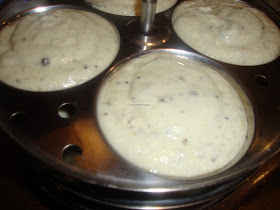Spiced Idli (Kanchipuram Idli, version 2)
A tamil channel has been telecasting a program in which Revathy Sankaran cooks traditional recipes along with her grand daughter. She says the intent is to help pass on the knowledge of those days to the future generation. She also shows some special utensils that were in use few decades back and I recall my grandmother mentioning them. So far, I must say the recipes have not been particularly new to me because all of them were cooked by my grandmother and mother. It does make me feel proud that way because I have been sticking to my intent of capturing as many traditional recipes as I have been exposed to through my previous generations. Anyway, there was one show in which she showed kanchipuram idli recipe and for all those who have read my post on this dish probably know how I have my complaint against leading chef who just add some mustard seeds, turmeric powder and curry leaves to normal idli dough and call it kanchipuram idli. So I was curious to find how she made it and most of it except one basic ingredient was the same. However, to me that difference was important because this recipe used a pulse instead of raw rice. I was obviously curious to try this recipe and found the results to be good. Honestly I was very unsure of how it would be and even thought I will bin the batter but it was a day that I thought something is better than nothing. The whole family liked the idlis. Some difference between my original kanchipuram idli and this is in the texture as the original is meant to be slightly coarse batter while this one is a fine batter. The softness and flavours are compatible. For those who like more pulses in their diet, you could try this recipe. Next time I would add some grated carrot just to get more veggies in. Here it is…
1 cup par boiled rice
½ cup urd dal
½ cup mung beans
1 teaspoon fenugreek seeds
Salt to taste
1 tablespoon gingelly oil or any oil
1 teaspoon cumin seeds
1 sprig curry leaves
½ teaspoon dry ginger powder (chukku podi)
1 teaspoon black peppercorns
1 teaspoon mustard seeds
1 teaspoon channa dal
few cashews, optional
Soak the beans, urd, rice and fenugreek together overnight. Grind to fine batter and add required salt. Allow batter to ferment well
Heat some oil and temper mustard seeds and channa dal. Once seeds crackles and dal browns, add to batter. Also add coarsely crushed pepper and cumin, curry leaves, dry ginger powder and oil. Mix well
Pour into idli moulds and steam for 15 minutes (until done)
Serve hot!


















































